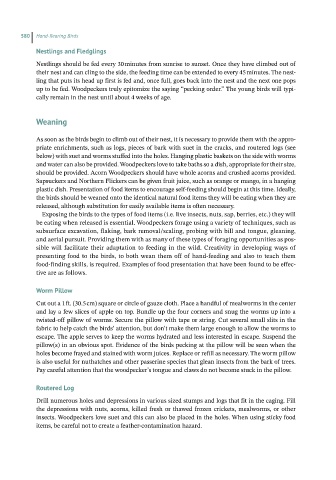Page 579 - Hand rearing birds second
P. 579
580 Hand-Rearing Birds
Nestlingsand Fledglings
Nestlings should be fed every 30 minutes from sunrise to sunset. Once they have climbed out of
their nest and can cling to the side, the feeding time can be extended to every 45 minutes. The nest-
ling that puts its head up first is fed and, once full, goes back into the nest and the next one pops
up to be fed. Woodpeckers truly epitomize the saying “pecking order.” The young birds will typi-
cally remain in the nest until about 4 weeks of age.
Weaning
As soon as the birds begin to climb out of their nest, it is necessary to provide them with the appro-
priate enrichments, such as logs, pieces of bark with suet in the cracks, and routered logs (see
below) with suet and worms stuffed into the holes. Hanging plastic baskets on the side with worms
and water can also be provided. Woodpeckers love to take baths so a dish, appropriate for their size,
should be provided. Acorn Woodpeckers should have whole acorns and crushed acorns provided.
Sapsuckers and Northern Flickers can be given fruit juice, such as orange or mango, in a hanging
plastic dish. Presentation of food items to encourage self‐feeding should begin at this time. Ideally,
the birds should be weaned onto the identical natural food items they will be eating when they are
released, although substitution for easily available items is often necessary.
Exposing the birds to the types of food items (i.e. live insects, nuts, sap, berries, etc.) they will
be eating when released is essential. Woodpeckers forage using a variety of techniques, such as
subsurface excavation, flaking, bark removal/scaling, probing with bill and tongue, gleaning,
and aerial pursuit. Providing them with as many of these types of foraging opportunities as pos -
sible will facilitate their adaptation to feeding in the wild. Creativity in developing ways of
presenting food to the birds, to both wean them off of hand‐feeding and also to teach them
food‐finding skills, is required. Examples of food presentation that have been found to be effec-
tive are as follows.
WormPillow
Cut out a 1 ft. (30.5 cm) square or circle of gauze cloth. Place a handful of mealworms in the center
and lay a few slices of apple on top. Bundle up the four corners and snug the worms up into a
twisted‐off pillow of worms. Secure the pillow with tape or string. Cut several small slits in the
fabric to help catch the birds’ attention, but don’t make them large enough to allow the worms to
escape. The apple serves to keep the worms hydrated and less interested in escape. Suspend the
pillow(s) in an obvious spot. Evidence of the birds pecking at the pillow will be seen when the
holes become frayed and stained with worm juices. Replace or refill as necessary. The worm pillow
is also useful for nuthatches and other passerine species that glean insects from the bark of trees.
Pay careful attention that the woodpecker’s tongue and claws do not become stuck in the pillow.
Routered Log
Drill numerous holes and depressions in various sized stumps and logs that fit in the caging. Fill
the depressions with nuts, acorns, killed fresh or thawed frozen crickets, mealworms, or other
insects. Woodpeckers love suet and this can also be placed in the holes. When using sticky food
items, be careful not to create a feather‐contamination hazard.

